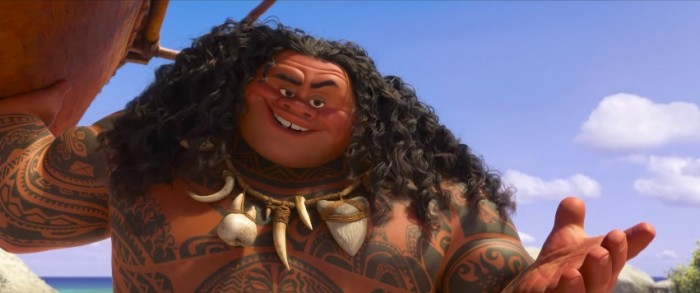'Moana' Directors Talk 'Mad Max: Fury Road' Influences And Taika Waititi's Screenplay
Over the Summer, I got the great opportunity to talk with filmmakers Ron Clements and John Musker about their upcoming Walt Disney Animation Studios film Moana. Ron & Jon are animation legends, having worked on many great Disney animated movies over the years, including The Great Mouse Detective, The Little Mermaid, Aladdin, Hercules, Treasure Planet and The Princess and the Frog.
Over the course of our discussion, Ron and Jon talk about how the project developed with Maui originally set to be the main character of the story, how Thor Ragnarok director Taika Waititi brought to the script, developing the musical elements, Lin-Manuel Miranda writing songs for The Rock to sing, how Mad Max: Fury Road helped inspired an action sequence featuring the Kakamora in the film. Hit the jump to read the full Moana interview.
Moana Interview: Ron Clements and John Musker
Peter Sciretta: So the idea for Moana came up five years ago?John Musker: Right. About five years.Peter: What was the first pitch? I'm really interested in the evolution of how it came to be.Ron Clements: It was really John's idea to begin with to tell a story set in the world of the South Pacific, Polynesia. He started, he just loved the world and he started reading a lot of mythology, which most people are not that familiar with. And then he got me reading the mythology and we very early on we worked up a basic storyline centered around the character of Maui. He just seemed like a great character to kind of build a movie around. He's this mythic demi-god, bigger than life character. He pulled up islands with his magical fishhook. He slowed down the sun. He's Pan Pacific. There are stories of Maui everywhere in the South Pacific. They're different. Different areas have different interpretations. But and so we fashioned, that was kind of the inspiration and we came up with a very simple basic storyline, focusing on Maui.Peter: So Maui was the main character at that point?Ron: He was the main character and we pitched that to John Lasseter. And he liked the idea very much. But he said you've got to dig deeper. You've gotta really go to this world. You've gotta spend time with these people. And we were not adverse to doing that. But obviously some of the most beautiful places in the world. But it turned out to be a very inspirational trip. We learned so much from the people that we met and we talked to. So when we came back from that trip, that was a two and a half week trip to Fiji, Samoa, Tahiti, Moorea. We really kind of threw out everything that we had in that story except the character of Maui. And then refashioned this kind of basic idea of actually focusing the story on a teenage girl, a kind of True Grit story where this girl who dreams of being a navigator, who has this the ocean and the voyaging is in her blood that she ends up teamed up with this demi-god on a quest to save her world.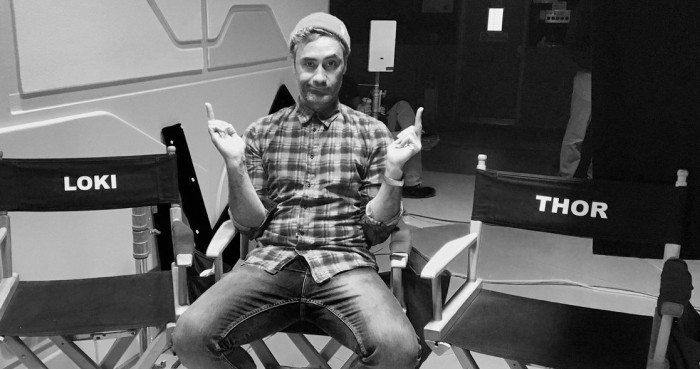 Peter: And can you talk a little Taika Waititi's involvement in the script? Was that in the early days when it was Maui?John: No, it was after that.Ron: It was afterwards, after our trip. So Taika came up... We kind of had and we sort of named this girl Moana, named after the ocean. And we had a very, a visual outline of the story. And we heard about Taika from people in the South Pacific that we talked to. 'Cause we usually on most of the films we've done, actually all the films we've done, except this film, we always wrote the first draft of the script. And we did not do that on this movie. And we really wanted someone from the culture to sort of do that. And we heard about Taika. We saw his movie Boy, which that he had directed and written and which was great. We read another one of his scripts that was great. And we brought him in, showed him what we were doing. He really liked the idea. And then and he worked on the movie I think for several months. And wrote the first draft of the script. And then he went back to New Zealand to direct What We Do In The Shadows. And we've seen him from time to time since then. And now he's directing Thor [Ragnarok].
Peter: And can you talk a little Taika Waititi's involvement in the script? Was that in the early days when it was Maui?John: No, it was after that.Ron: It was afterwards, after our trip. So Taika came up... We kind of had and we sort of named this girl Moana, named after the ocean. And we had a very, a visual outline of the story. And we heard about Taika from people in the South Pacific that we talked to. 'Cause we usually on most of the films we've done, actually all the films we've done, except this film, we always wrote the first draft of the script. And we did not do that on this movie. And we really wanted someone from the culture to sort of do that. And we heard about Taika. We saw his movie Boy, which that he had directed and written and which was great. We read another one of his scripts that was great. And we brought him in, showed him what we were doing. He really liked the idea. And then and he worked on the movie I think for several months. And wrote the first draft of the script. And then he went back to New Zealand to direct What We Do In The Shadows. And we've seen him from time to time since then. And now he's directing Thor [Ragnarok].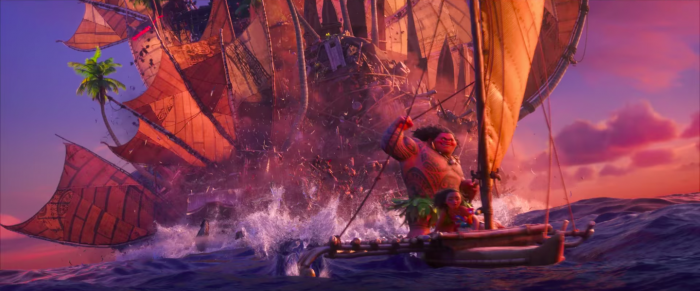 Peter: Was this always gonna be a musical?Ron: Yeah, I think so. I think even before we took our trip, we thought of it as a musical. And certainly our trip–John: I mean, we were hearing music all the way through the islands. You know, we, when we visit the islands, of course since the islands have been churches have come down, there's a church every two blocks. And so there's music in all these different denominations. There's the Catholic church and the Protestant church and this church and the Mahdi church. But music is a part of the islands there. And it's they sing songs of farewell. They sing songs, work songs and all that. So we just felt like and it's such a rich, man, we heard songs before we went too. And after that's been recorded in the field by this British guy, David Fanshaw [PH], who recorded these a cappella fires of people that just sounded so transportive. You know, just so emotive and powerful. So we said, music's gotta play a big part of this movie to really capture the culture. So we, when we did the early outline, we had ideas for where songs might go. But like anything, we want the songs to advance the story. So as the story changed, where the songs would land changed. You know, we always thought there'd be a song about Maui because he's one of the important characters. We thought there'd be an aspirational song she would sing about what's inside of her emotionally. And we did want to have something that one of the big things, you know, they were the world's greatest navigators. This whole thing, you know, they sailed using dead reckoning without instruments. We wanted a musical number that would capture the exhilaration of being out on a boat as they were and sailing with the stars and all that. So that's the origin of We Know the Way. From very early on we said, for an audience that doesn't know this, what we need a song that can really have the kind of sweep and the, you know, pull you in. So that was early on, we conceived of like that should be a musical moment. So...Peter: But there's gonna be a traditional musical element with characters singing about–John: Characters are actually gonna sing on stage, they will yeah. We did, the clips we showed didn't happen to have that, and I think the way, of course, they manage things here, they wanna roll that out eventually. But the characters do sing.
Peter: Was this always gonna be a musical?Ron: Yeah, I think so. I think even before we took our trip, we thought of it as a musical. And certainly our trip–John: I mean, we were hearing music all the way through the islands. You know, we, when we visit the islands, of course since the islands have been churches have come down, there's a church every two blocks. And so there's music in all these different denominations. There's the Catholic church and the Protestant church and this church and the Mahdi church. But music is a part of the islands there. And it's they sing songs of farewell. They sing songs, work songs and all that. So we just felt like and it's such a rich, man, we heard songs before we went too. And after that's been recorded in the field by this British guy, David Fanshaw [PH], who recorded these a cappella fires of people that just sounded so transportive. You know, just so emotive and powerful. So we said, music's gotta play a big part of this movie to really capture the culture. So we, when we did the early outline, we had ideas for where songs might go. But like anything, we want the songs to advance the story. So as the story changed, where the songs would land changed. You know, we always thought there'd be a song about Maui because he's one of the important characters. We thought there'd be an aspirational song she would sing about what's inside of her emotionally. And we did want to have something that one of the big things, you know, they were the world's greatest navigators. This whole thing, you know, they sailed using dead reckoning without instruments. We wanted a musical number that would capture the exhilaration of being out on a boat as they were and sailing with the stars and all that. So that's the origin of We Know the Way. From very early on we said, for an audience that doesn't know this, what we need a song that can really have the kind of sweep and the, you know, pull you in. So that was early on, we conceived of like that should be a musical moment. So...Peter: But there's gonna be a traditional musical element with characters singing about–John: Characters are actually gonna sing on stage, they will yeah. We did, the clips we showed didn't happen to have that, and I think the way, of course, they manage things here, they wanna roll that out eventually. But the characters do sing.
Peter: Dwayne? (note: this interview was conducted months before the clip of The Rock singing was released)John: Dwayne sings on stage yes.Ron: He does in fact sing. He was very excited about doing a song. He had a song that Lin-Manuel Miranda wrote specifically for him and he did a great job. And it's a showstopper. One of the fun moments of the movie. And there are others.John: But we've always liked music in movies, you know, just 'cause it helps tell the story. It can be emotional. It can be funny. It can be so many different things. And it just and it gives you variety from and again, there's a certain stylization that happens with music. Animation and music seem to go together well.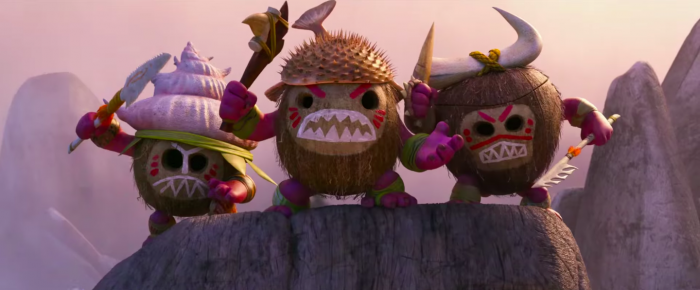 Peter: One of the favorite sequences was with these little guys – the Kakamora. And what one of you guys called "Disney meets Mad Max: Fury Road on the high seas." Can you talk a little bit about that? 'Cause it seems kind of epic and –John: Well it is epic and it is scale–Ron: It's a much bigger sequence than what we showed.John: Yeah, you're gonna see even more stuff. I mean, early on, we actually a couple of the writers that we worked with on this, Jordan and Aaron Kandell, suggested the idea of the Kakamora, like there's these little Sprite characters in the South Pacific called Menehune in Hawaii. In other islands they're like little, they're almost like Leprechauns or something like that. But we thought where could we get our heroes involved with some kind of battle with people like this? 'Cause they, some of them were known to be tricksters and thieves. At night, they would take things. So out of that little idea grew this big idea, what if they were like scavengers? And then they, I think some of visual development people did these drawings and well what if there are these big barges and they sort of turned into, you know, this big barge thing. And then John Ripa who storyboarded this I mentioned he and I think he was inspired by, you know–Ron: Before that there was the idea of they wore coconut armor.John: Yeah. That was actually driven by economy as much as anything because it was sort of like we can't have characters that are we're gonna see a lot of detail on. So a way we can avoid that. So it's like what if we clad them in coconuts and then John Ripa's like what if we make it big scale? It's gonna be like monumental. It's also caricatured those things. So literally there are like thousands of them, and they're like marauders, and it is an absolute action set piece. And it's a fun action set piece where they are pursued by these guys, and it's been John did a great job storyboarding it. And we have animators who do the principal characters, but we have animators who do when there are multiple characters in a scene, they kind of do those characters. And they've had a field day just coming up with fun behavior for these crazy guys. The other thing we're gonna do and which we haven't yet done is on our soundtrack; I think we're gonna give them some kind of weird lingo or something like that just to sort of make their threat a little more real, which our sound designer is working on right now. But anyway, it's a total action set piece, and it's crazy scale, but it's been fun to do.
Peter: One of the favorite sequences was with these little guys – the Kakamora. And what one of you guys called "Disney meets Mad Max: Fury Road on the high seas." Can you talk a little bit about that? 'Cause it seems kind of epic and –John: Well it is epic and it is scale–Ron: It's a much bigger sequence than what we showed.John: Yeah, you're gonna see even more stuff. I mean, early on, we actually a couple of the writers that we worked with on this, Jordan and Aaron Kandell, suggested the idea of the Kakamora, like there's these little Sprite characters in the South Pacific called Menehune in Hawaii. In other islands they're like little, they're almost like Leprechauns or something like that. But we thought where could we get our heroes involved with some kind of battle with people like this? 'Cause they, some of them were known to be tricksters and thieves. At night, they would take things. So out of that little idea grew this big idea, what if they were like scavengers? And then they, I think some of visual development people did these drawings and well what if there are these big barges and they sort of turned into, you know, this big barge thing. And then John Ripa who storyboarded this I mentioned he and I think he was inspired by, you know–Ron: Before that there was the idea of they wore coconut armor.John: Yeah. That was actually driven by economy as much as anything because it was sort of like we can't have characters that are we're gonna see a lot of detail on. So a way we can avoid that. So it's like what if we clad them in coconuts and then John Ripa's like what if we make it big scale? It's gonna be like monumental. It's also caricatured those things. So literally there are like thousands of them, and they're like marauders, and it is an absolute action set piece. And it's a fun action set piece where they are pursued by these guys, and it's been John did a great job storyboarding it. And we have animators who do the principal characters, but we have animators who do when there are multiple characters in a scene, they kind of do those characters. And they've had a field day just coming up with fun behavior for these crazy guys. The other thing we're gonna do and which we haven't yet done is on our soundtrack; I think we're gonna give them some kind of weird lingo or something like that just to sort of make their threat a little more real, which our sound designer is working on right now. But anyway, it's a total action set piece, and it's crazy scale, but it's been fun to do.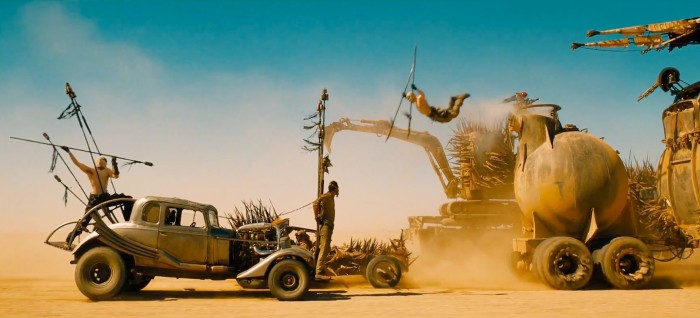 Peter: When you guys saw Fury Road, were you like...?John: Yeah. Well, we were inspired. I mean, I loved Road Warrior the first time. I saw The Road Warrior before I saw Mad Max, you know, I saw it in reverse order. And so I was, I've always been a fan of George Miller. This sequence I think got storyboarded after Fury Road came out I think as I recall. So I think, you know, we were inspired, but I think John was, it's a bit of an homage to it. But it, we really wanted to make it a big scale, you know, kinetic thing. And I think George Miller's a master of that kind of stuff.
Peter: When you guys saw Fury Road, were you like...?John: Yeah. Well, we were inspired. I mean, I loved Road Warrior the first time. I saw The Road Warrior before I saw Mad Max, you know, I saw it in reverse order. And so I was, I've always been a fan of George Miller. This sequence I think got storyboarded after Fury Road came out I think as I recall. So I think, you know, we were inspired, but I think John was, it's a bit of an homage to it. But it, we really wanted to make it a big scale, you know, kinetic thing. And I think George Miller's a master of that kind of stuff.

